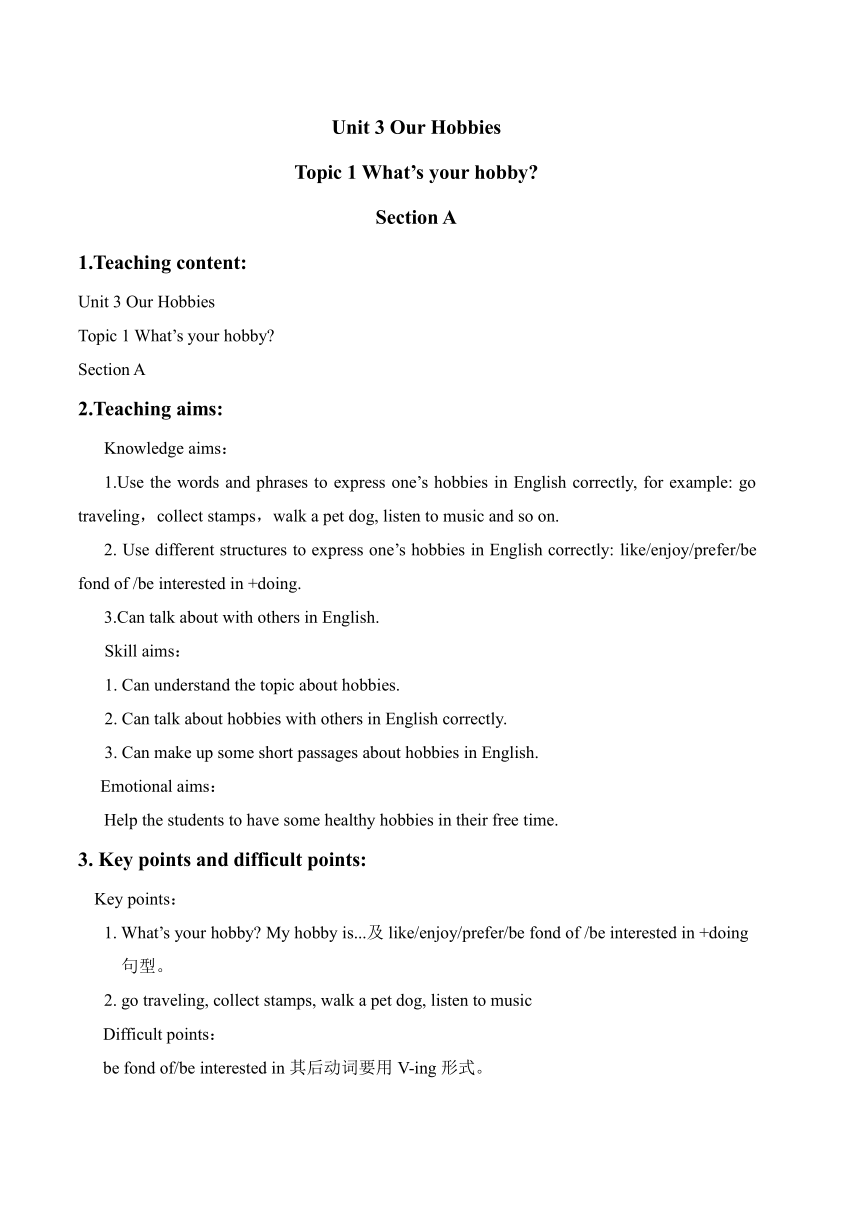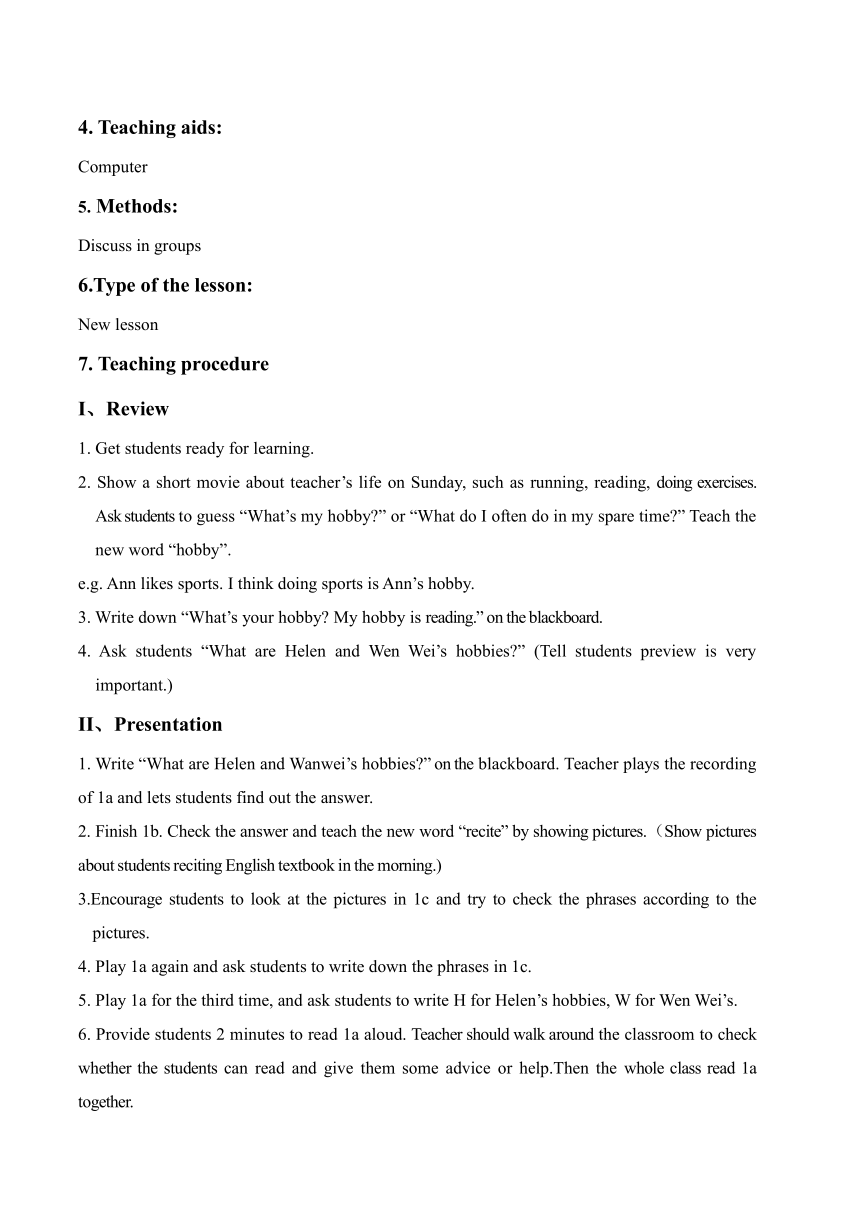Module 3 Unit 2 What’s your hobby?教学设计(基本全英)
文档属性
| 名称 | Module 3 Unit 2 What’s your hobby?教学设计(基本全英) |  | |
| 格式 | zip | ||
| 文件大小 | 6.1KB | ||
| 资源类型 | 教案 | ||
| 版本资源 | 外研版(三年级起点) | ||
| 科目 | 英语 | ||
| 更新时间 | 2018-08-29 11:05:57 | ||
图片预览


文档简介
Unit 3 Our Hobbies
Topic 1 What’s your hobby?
Section A
Teaching content:
Unit 3 Our Hobbies
Topic 1 What’s your hobby?
Section A
Teaching aims:
Knowledge aims:
1.Use the words and phrases to express one’s hobbies in English correctly, for example: go traveling,collect stamps,walk a pet dog, listen to music and so on.
2. Use different structures to express one’s hobbies in English correctly: like/enjoy/prefer/be fond of /be interested in +doing.
3.Can talk about with others in English.
Skill aims:
1. Can understand the topic about hobbies.
2. Can talk about hobbies with others in English correctly.
3. Can make up some short passages about hobbies in English.
Emotional aims:
Help the students to have some healthy hobbies in their free time.
3. Key points and difficult points:
Key points:
1. What’s your hobby? My hobby is...及like/enjoy/prefer/be fond of /be interested in +doing
句型。
2. go traveling, collect stamps, walk a pet dog, listen to music
Difficult points:
be fond of/be interested in其后动词要用V-ing形式。
4. Teaching aids:
Computer
5. Methods:
Discuss in groups
6.Type of the lesson:
New lesson
7. Teaching procedure
I、Review
1. Get students ready for learning.
2. Show a short movie about teacher’s life on Sunday, such as running, reading, doing exercises. Ask students to guess “What’s my hobby?” or “What do I often do in my spare time?” Teach the new word “hobby”.
e.g. Ann likes sports. I think doing sports is Ann’s hobby.
3. Write down “What’s your hobby? My hobby is reading.” on the blackboard.
4. Ask students “What are Helen and Wen Wei’s hobbies?” (Tell students preview is very important.)
II、Presentation
1. Write “What are Helen and Wanwei’s hobbies?” on the blackboard. Teacher plays the recording of 1a and lets students find out the answer.
2. Finish 1b. Check the answer and teach the new word “recite” by showing pictures.(Show pictures about students reciting English textbook in the morning.)
Encourage students to look at the pictures in 1c and try to check the phrases according to the pictures.
4. Play 1a again and ask students to write down the phrases in 1c.
5. Play 1a for the third time, and ask students to write H for Helen’s hobbies, W for Wen Wei’s.
6. Provide students 2 minutes to read 1a aloud. Teacher should walk around the classroom to check whether the students can read and give them some advice or help.Then the whole class read 1a together.
7. Finish 1d. Ask students to read 1a and fill in the blanks.
III、Consolidation and Practice
1. Check the answers in 1d and write “Wen Wei enjoys reading stories and listening. Helen loves reciting poems.” on the blackboard. Tell students there are different ways to express the same meaning. Encourage students to find out other sentences which can express the same meaning.
2. Finish 2. Ask students to fill in the blanks in 2 according to the pictures. Then play the recording of 2.
3. Write down “like/be fond of/be interested in /enjoy /prefer” on the blackboard.
4. Ask students to look at 2 carefully and summarize the usage of “like/be fond of/be interested in/ enjoy /prefer”.
5. Teacher explains some key points and difficult points to the students:
(1) The structure of “like/be fond of / be interested in enjoy/ prefer+doing”
(2) The key sentences “What’s your hobby?” “My hobby is reading.” Then give students some exercises to check whether they have mastered them.
Homework:
(1) Writing: Write a short passage about hobbies using the sentences we studied today.
(2) Prepare Section B after class.
Unit 3 Our Hobbies
Topic 1 What’s your hobby?
Section A
What’s your hobby?
My hobby is ...
I like /prefer/love/enjoy/am fond of + doing
What are Wen Wei and Helen’s hobbies?
Wen Wei enjoys reading stories and listening. Helen loves reciting poems.
The blackboard design
10.Teaching Reflection
It’s easy for the students to use the structure of “prefer/be fond of/be interested in/love + doing” after teaching, but it’s hard for them to remember these phrases which are related to the hobbies or outdoor activities. Teachers should think of more ways to practice these phrases.
Topic 1 What’s your hobby?
Section A
Teaching content:
Unit 3 Our Hobbies
Topic 1 What’s your hobby?
Section A
Teaching aims:
Knowledge aims:
1.Use the words and phrases to express one’s hobbies in English correctly, for example: go traveling,collect stamps,walk a pet dog, listen to music and so on.
2. Use different structures to express one’s hobbies in English correctly: like/enjoy/prefer/be fond of /be interested in +doing.
3.Can talk about with others in English.
Skill aims:
1. Can understand the topic about hobbies.
2. Can talk about hobbies with others in English correctly.
3. Can make up some short passages about hobbies in English.
Emotional aims:
Help the students to have some healthy hobbies in their free time.
3. Key points and difficult points:
Key points:
1. What’s your hobby? My hobby is...及like/enjoy/prefer/be fond of /be interested in +doing
句型。
2. go traveling, collect stamps, walk a pet dog, listen to music
Difficult points:
be fond of/be interested in其后动词要用V-ing形式。
4. Teaching aids:
Computer
5. Methods:
Discuss in groups
6.Type of the lesson:
New lesson
7. Teaching procedure
I、Review
1. Get students ready for learning.
2. Show a short movie about teacher’s life on Sunday, such as running, reading, doing exercises. Ask students to guess “What’s my hobby?” or “What do I often do in my spare time?” Teach the new word “hobby”.
e.g. Ann likes sports. I think doing sports is Ann’s hobby.
3. Write down “What’s your hobby? My hobby is reading.” on the blackboard.
4. Ask students “What are Helen and Wen Wei’s hobbies?” (Tell students preview is very important.)
II、Presentation
1. Write “What are Helen and Wanwei’s hobbies?” on the blackboard. Teacher plays the recording of 1a and lets students find out the answer.
2. Finish 1b. Check the answer and teach the new word “recite” by showing pictures.(Show pictures about students reciting English textbook in the morning.)
Encourage students to look at the pictures in 1c and try to check the phrases according to the pictures.
4. Play 1a again and ask students to write down the phrases in 1c.
5. Play 1a for the third time, and ask students to write H for Helen’s hobbies, W for Wen Wei’s.
6. Provide students 2 minutes to read 1a aloud. Teacher should walk around the classroom to check whether the students can read and give them some advice or help.Then the whole class read 1a together.
7. Finish 1d. Ask students to read 1a and fill in the blanks.
III、Consolidation and Practice
1. Check the answers in 1d and write “Wen Wei enjoys reading stories and listening. Helen loves reciting poems.” on the blackboard. Tell students there are different ways to express the same meaning. Encourage students to find out other sentences which can express the same meaning.
2. Finish 2. Ask students to fill in the blanks in 2 according to the pictures. Then play the recording of 2.
3. Write down “like/be fond of/be interested in /enjoy /prefer” on the blackboard.
4. Ask students to look at 2 carefully and summarize the usage of “like/be fond of/be interested in/ enjoy /prefer”.
5. Teacher explains some key points and difficult points to the students:
(1) The structure of “like/be fond of / be interested in enjoy/ prefer+doing”
(2) The key sentences “What’s your hobby?” “My hobby is reading.” Then give students some exercises to check whether they have mastered them.
Homework:
(1) Writing: Write a short passage about hobbies using the sentences we studied today.
(2) Prepare Section B after class.
Unit 3 Our Hobbies
Topic 1 What’s your hobby?
Section A
What’s your hobby?
My hobby is ...
I like /prefer/love/enjoy/am fond of + doing
What are Wen Wei and Helen’s hobbies?
Wen Wei enjoys reading stories and listening. Helen loves reciting poems.
The blackboard design
10.Teaching Reflection
It’s easy for the students to use the structure of “prefer/be fond of/be interested in/love + doing” after teaching, but it’s hard for them to remember these phrases which are related to the hobbies or outdoor activities. Teachers should think of more ways to practice these phrases.
同课章节目录
- Module 1
- Unit 1 It's more than twenty thousand kilometers l
- Unit 2 It's in the west.
- Module 2
- Unit 1 There's Chinese dancing.
- Unit 2 There are lots of beautiful lakes in China.
- Module 3
- Unit 1 Collecting stamps is my hobby.
- Unit 2 What's your hobby?
- Module 4
- Unit 1 Thanksgiving is my favourite festival.
- Unit 2 Our favourite festival is the Spring Festiv
- Module 5
- Unit 1 Can you be my Chinese pen friend?
- Unit 2 I can speak French.
- Module 6
- Unit 1 You've got a letter from New York.
- Unit 2 I've got a stamp from China.
- Module 7
- Unit 1 I don't believe it.
- Unit 2 Pandas love bamboo.
- Module 8
- Unit 1 Do you often play with dolls?
- Unit 2 I often go swimming.
- Module 9
- Unit 1 Do you want to visit the UN building?
- Unit 2 I want to go to Shanghai.
- Review Module
- Unit 1
- Unit 2
- Module 10
- Unit 1 Don't talk in the library.
- Unit 2 Go straight on!
